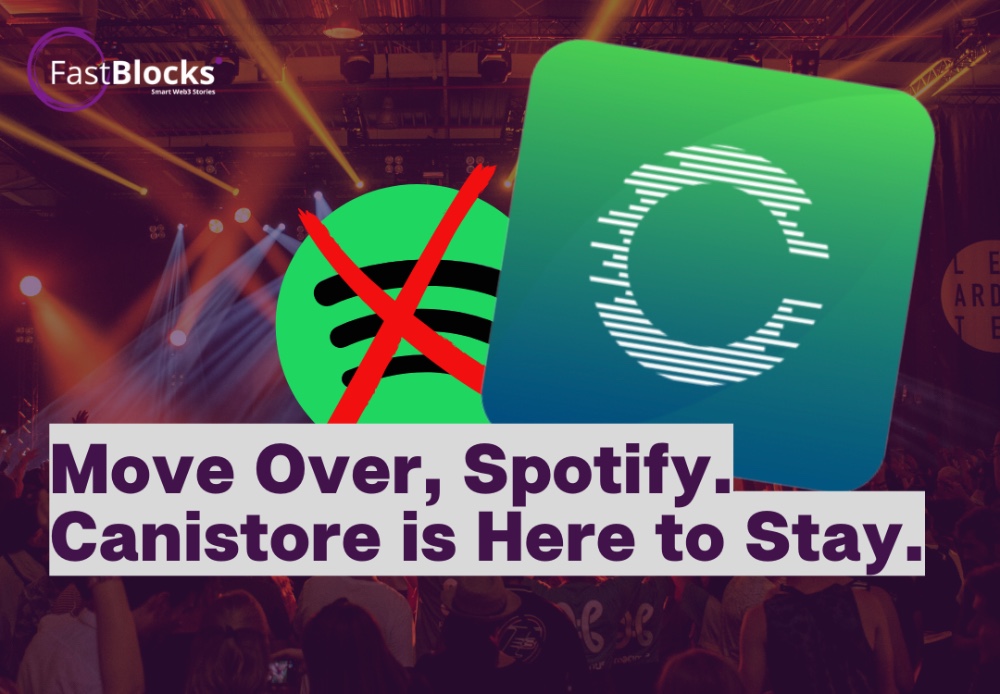In the age of blockchain technology, several companies are in the race to become the first major platform to provide financial independence for recording artists. But one of them shines brighter than all others.

Most of us understand that blockchain technology provides more freedom for creators, with superior opportunities for the monetization of content and the verification of its ownership. They are no longer required to share a lion’s portion of their earnings with Web2 platform intermediaries.
A month ago, I was invited to an ICP Community meetup in Zürich, where I had the pleasure of meeting Canistore’s CEO, Barry Paisley. To say that the enthusiasm in his eyes (while talking about his project) was inspiring would be an understatement. My mind was blown.
What is Canistore?
Canistore is a decentralized platform, living on the Internet Computer, where musicians can monetize their content. Uploading files as NFTs on Canistore offers the most effective means for music artists to monetize and own 100% of their content. Musicians sign up, go through a simple verification process and, once verified, upload their tunes to be shared with their fans.
On FastBlocks, we have often talked about how decentralized social media can provide creators with the much-needed freedom to share and license their work through the blockchain, where they can take full control of their creations. The process is simple, and Canistore is here to help us move forward with a new way to share our creativity online.
How Did Canistore Become What It Is Today and How It Will Develop In The Future?
The main reason a product gets developed is to solve an immediate need in the marketplace – to provide a value-added solution to a common problem. The problem that inspired the birth of Canistore is a very common one faced by creators who release their work through corporate-owned Web2 platforms.
Currently, most musicians share their work on Youtube, SoundCloud, Spotify, etc., which prevents them from earning the full amount they deserve; furthermore, the intellectual property rights of their creations are seldom adequately protected.
The earnings on Spotify, for example, are shared on a 30/70 basis. This means the platform takes a 30% commission from the revenue, while the other 70% is distributed between the artist and the rights holders.
What’s great about Canistore, is that the platform’s developers are legitimate artists. They were tired of being mistreated and undervalued by big tech companies and decided to do something about it. A glance at Mr. Barry Paisley’s introduction shows how he was able to take a handful of ideas on blockchain content development (from a few trusted colleagues) and spin it into a platform that is poised to completely reinvent how digital content is produced, distributed, and rewarded.
Let’s Break Down a Few Terms, So We Can Better Understand What Canistore Is All About.
Licensing Protocol (dApp)
Canistore’s licensing protocol proves ownership through timestamps. It also includes a legally binding agreement with global recognition. This means that any creator who licenses their work on Canistore can distribute it on every content-sharing platform while maintaining 100% ownership over it.
Cani – The Community’s Token
“At the heart of the Canistore ecosystem lies the Cani token, the digital currency that allows creators to easily monetize their content. “
This means that through Canistore’s native token, all the content on the platform can be governed by the community HODLRs, instead of an intermediary company that makes important decisions on behalf of its community without their direct participation.
Can’t believe it? There’s more! – Cani Club
Canistore is the first Web3 dApp to have its physical location, called Cani Club.
It’s a three-story building, located in London. It also has its own NFT membership card, which can be minted on Entrepot.
A more in-depth analysis of their tokenomics can be found on Nuance.
What’s next for Canistore?
Following Canistore’s journey has been incredibly exciting so far. As one of the most promising dApps currently being developed on the Internet Computer, I highly recommend that musicians (and content creators of all types) keep a close watch on their roadmap, as new features and functions are being released often.
What else would you like to see coming to the Internet Computer in the future?
*Originally published on fastblocks.com